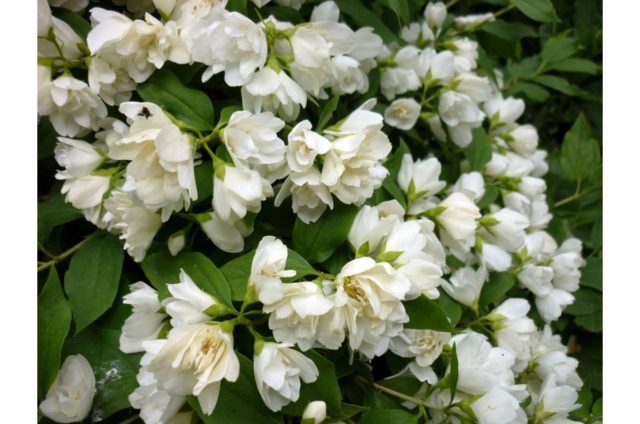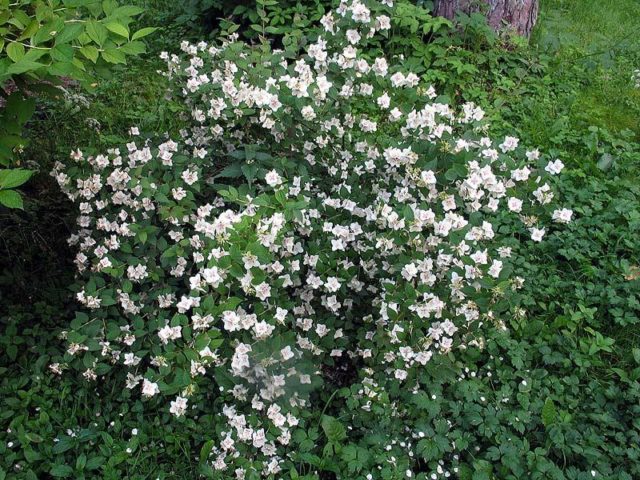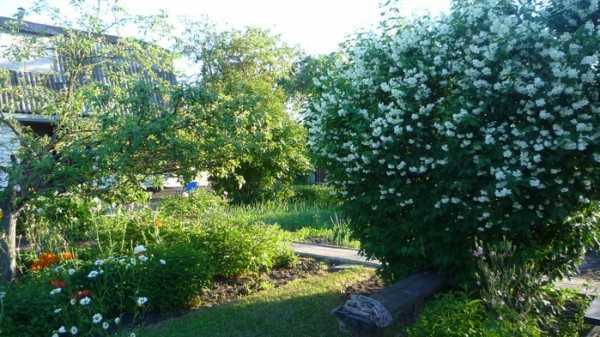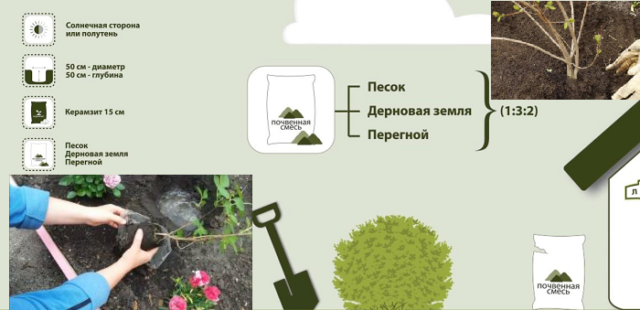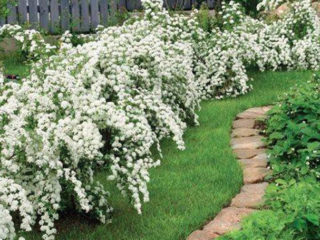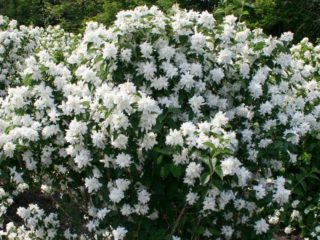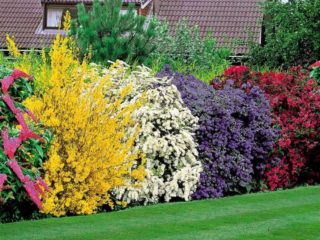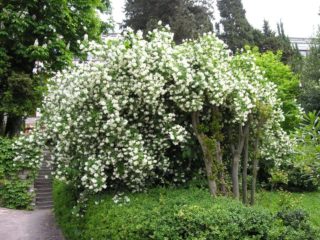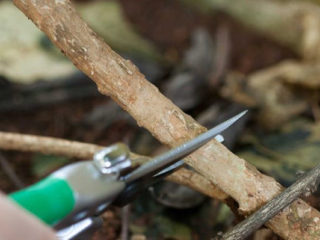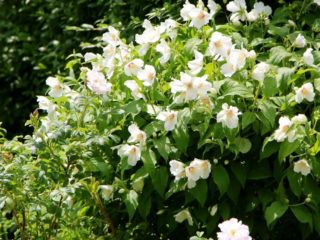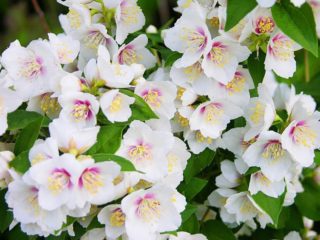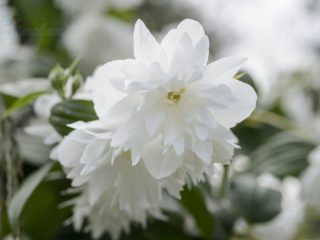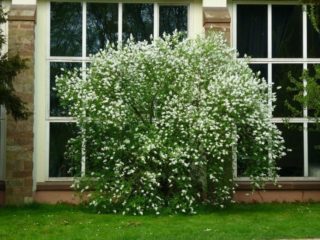Content
At the end of spring and beginning of summer, many gorgeous plants bloom in private gardens in central Russia. The mock orange Ermine mantle deserves special attention, exuding a fragrant, very pleasant aroma and striking with a terry mantle of snow-white flowers, abundantly located on the ampelous branches. For its delicate, sweet aroma and external resemblance to a jasmine bush, mock orange is popularly nicknamed garden jasmine.
Description of jasmine Ermine mantle
Chubushnik variety Ermine Mantle is a garden, deciduous plant that belongs to the Hydrangeaceae family. This is a shrub up to 1 - 1.5 m high, which without pruning can grow up to 3 m, with drooping, downward inclined shoots, compact and very decorative during flowering. Its leaves are narrowed towards the upper part, oval in shape with clearly defined veins.
How mock orange blooms Ermine mantle
During flowering, the downward inclined branches of the mock orange Manteau d’Hermine are completely strewn with large, white flowers, fragrant, with a strawberry aroma. The bush is completely covered with a snow-white scattering of flowers, reminiscent of a mantle of delicate, light fur. Semi-double flowers with narrow petals reach 4 cm in diameter. Thin, ampelous branches with numerous Ermine mantle jasmine flowers surprise with their amazing beauty for a long time - up to 2 months, which is clearly shown in the photo. The crop blooms at the end of May and blooms until the beginning of July.
Main characteristics
Chubushnik Ermine mantle is a crop that is unpretentious to growing conditions. It prefers sunny places, protected from cold winds, but can tolerate light afternoon shade. In the shade, the ampelous branches stretch out, become thin and weak, and their flowering is short-lived and rare. Garden jasmine grows well and blooms profusely in moist, fertile, but not waterlogged soils. Needs periodic feeding and pruning. Mock orange variety Manteau d’Hermine does not tolerate swampy, damp soils.
Features of reproduction
Garden jasmine Ermine mantle can be propagated in several ways:
- layering or cuttings;
- dividing the bush;
- seeds.
Manteau d’Hermine seeds are planted in prepared soil in late autumn, before the onset of severe frosts, and covered with spruce branches. They are saturated with moisture when the snow melts, which subsequently ensures the active growth of young shoots.The main advantage of the method of propagation by seeds is the resistance of seedlings to pests, diseases, and their good immunity. But they bloom only in the 8th year after germination.
Cuttings for seedlings are cut in the fall after the mock orange Ermine mantle blooms and stored in damp sand at a temperature of 0 degrees. In the spring they are planted in greenhouses, and the young shoots that appear are cut down to soil level. Only next spring can the seedlings be planted in a permanent place. For layering, healthy, strong shoots are cut to 5 cm. After new shoots appear, the cut site is secured with wire. Over time, the sprout will turn into a root system for a new seedling.
When transplanting Manteau d'Hermine jasmine to a new location, you can propagate it by dividing the bush. The day before the procedure, the plant is watered abundantly, then dug up and divided into separate rhizomes with a sharp knife. Planting of rhizomes is carried out in a manner similar to the main planting of jasmine seedlings.
Planting and care
It is better to plant Ermine mantle jasmine in sunny places with fertile, loose soils, without close groundwater. It is indispensable for organizing hedges, borders and for designing various compositions of perennials. On a personal plot it will look impressive along garden paths. The mock orange Ermine mantle, as seen in the photo, combines with other beautifully flowering and ornamental plants.
Recommended timing
In order for the mock orange variety Ermine Mantle to take root well, get stronger and bloom, as in the photo, planting is carried out in early spring or early summer. In regions with slightly cold winters, the shrub can be planted in the fall - late September-early October, so that the plant has time to gain strength and safely overwinter.However, spring planting is more expedient and gives a better chance of growing a strong, beautifully flowering shrub.
Site selection and soil preparation
Mock orange will feel great on moist, loamy soils. A fertile soil mixture of sand, humus and soil from rotted leaves must be added to the planting hole. Jasmine Manteau d'Hermine does not tolerate stagnant moisture, so when planting it needs to be provided with good drainage up to 20 cm from broken brick, sand or pebbles.
Landing algorithm
The planting hole for Manteau d’Hermine mock orange should be at least 60 cm deep. When planting in groups, for example, for a hedge, the distance between the holes should be 0.5 m. The places for planting need to be prepared in advance, since it is carried out in several stages:
- drainage is poured into prepared planting holes;
- the fertile mixture is laid at 20 - 25 cm;
- the earth should settle and settle within 7 - 9 days;
- garden jasmine is planted so that the root collar remains at ground level;
- the seedling is covered with the remaining fertile mixture;
- the soil is slightly compacted and watered abundantly - on average, about 30 liters of water per bush of Ermine Mantle mock orange;
- the root circle is mulched with peat, sawdust, leaves or humus.
Growing rules
Decorative mock orange Manteau d’Hermine will delight you with its stunning beauty and fragrance if you adhere to the following agricultural practices when growing:
- spring planting of mock orange seedlings should be carried out in the early periods, that is, before the buds open;
- Autumn planting should not be delayed; garden jasmine should be planted in a permanent place by mid-October;
- in the absence of a sunny place, mock orange can be planted in the shade, but in this case it requires careful, intensive care;
- wood ash added to the soil before planting will bring great benefits to jasmine, supplying the root system with the necessary microelements.
Caring for mock orange Philadelphus variety Ermine Mantle is not difficult. The features of agrotechnical measures will be discussed below.
Watering schedule
Mock orange variety Manteau d'Hermine is quite demanding on soil moisture, however, when watering, the main thing is to prevent stagnation of moisture, which will cause root rot. If there is a lack of moisture, the buds will wither and the plant will shed its flowers early. The optimal watering schedule in the spring-summer period is once a week, when the top layer of soil dries out. The amount of water for a single watering should be 20 - 30 liters, depending on the age of the mock orange. During drought, the frequency of watering is increased to 2 - 3 times a week. The shrub especially needs a sufficient amount of moisture during abundant flowering. The water should be warm and settled. To maintain moisture, it is recommended to periodically spray the jasmine Ermine mantle.
Weeding, loosening, mulching
Weeding is done if necessary, loosening is done periodically, a few hours after abundant watering of the jasmine. A technique such as mulching helps maintain soil moisture and provides additional nutrition to the plant. Mulching is carried out with sawdust, peat, compost or fallen leaves. It is definitely worth mulching the soil after the last, autumn pruning of the Manteau d’Hermine mock orange, thereby preparing it for winter.
Feeding schedule
The full development of Ermine mantle jasmine is impossible without fertilizing, which can be done from the age of 2.The fertilizer application schedule is as follows:
- the first feeding is carried out in the spring before the buds open with mineral fertilizers (potassium sulphide, urea - 15 g each, superphosphate - 30 g per 10 liters of water);
- The same fertilizing is done before flowering begins;
- at the beginning of autumn, mock orange will appreciate organic feeding from compost, rotted manure with the addition of wood ash. Fertilizers are applied when digging the tree trunk circle.
10 liters of diluted mineral fertilizers are enough to feed 2 mock orange bushes. The described organic fertilizer can be replaced with slurry, which is taken in a ratio of 1/10 to water. Apply organic fertilizing once a year.
Trimming
In the spring, mandatory sanitary pruning of the Manteau d’Hermine mock orange is carried out with the removal of frozen, damaged, dry branches. In addition, weak and too long shoots are pruned to half their length. In autumn, it is necessary to remove old branches and faded flowers, giving the plant a neat shape. Rejuvenating and formative pruning of garden jasmine with the removal of bare branches and wilted flowers is carried out if necessary after flowering. All cut areas are treated with a disinfectant.
Preparing for winter
Jasmine Ermine mantle is a fairly frost-resistant plant that can tolerate drops in air temperature to 18 - 20 degrees below zero. But young plants and new shoots that appear in the fall can freeze in severe winters and at higher temperatures. Therefore, covering it with agricultural fiber or several layers of burlap is a mandatory measure in order for the mock orange to overwinter safely.
Pests and diseases
The mock orange variety Manteau d’Hermine is most often affected by pests and diseases:
- spider mite;
- fungal spotting;
- aphids and butterfly caterpillars.
Spraying with fungicides will help cope with diseases. Drugs such as Intavir, Iskra, and Aktelik are effective against pests.
Conclusion
Chubushnik Ermine mantle looks great as a tapeworm on lawn areas, near gazebos, benches, and ponds. It can serve as a spectacular backdrop for low green plants. Jasmine is also widely used in group plantings to create decorative hedges. Long flowering will allow you to enjoy the stunning beauty of the country flora.
